Anti-Racism Teaching and Learning Resources
Everyone should start with critical self-reflection and awareness to understanding one’s social positions within the broader context of race and power to make effective structural changes. The resources provided here are organized to support teaching and learning in specific categories of diversity education. They can be accessed for instructional and personal use for faculty, staff, and students.
A Glossary of Common Terms and Concepts
- Anti-Racism – A framework for ending racism that goes beyond tolerating or celebrating racial diversity and addresses racism as a system of unequal institutional power between Whites and peoples of Color.
- Belonging – Being able to be present with your authentic identity and feeling that you fit in and that you are an important member of a group.
- Diversity – The representation of all our varied identities and differences, collectively and as individuals.
- Equity/Equality – The term “equity” refers to fairness and justice and is distinguished from equality: whereas equality means providing the same to all, equity means recognizing that we do not all start from the same place and must acknowledge and adjust imbalances. The process is ongoing, requiring us to identify and overcome intentional and unintentional barriers arising from bias or systemic structures.
- Inclusion – The practice or policy of providing equal access to opportunities and resources for people who might otherwise be excluded or marginalized, such as those who have physical or intellectual disabilities or Black, Indigenous, or Peoples of Color (BIPOC).
- Intersectionality – The understanding that we simultaneously occupy multiple identities that these identities do not cancel each other out; they interact in complex ways that must be explored and understood.
- Justice – The work necessary to create a society in which people are able to receive their fair share of opportunities, resources, safety, and so forth, taking into account historical inequities.
- Microaggression – A term used for commonplace daily verbal, behavioral or environmental slights, whether intentional or unintentional, that communicate hostile, derogatory, or negative attitudes toward stigmatized or culturally marginalized groups.
- Racism – Prejudice and discrimination supported by institutional power and authority used to the advantage of Whites and the disadvantage of peoples of Color. Racism encompasses economic, political, social, and institutional actions and beliefs that perpetuate an unequal distribution of privileges, resources, and power between White people and peoples of Color.
- Structural Racism – The interplay of policies, practices and programs of differing institutions which leads to adverse outcomes and conditions for communities of color compared to White communities that occurs within the context of racialized historical and cultural conditions.
- Institutional Racism – Policies, practice, and procedures that work to the benefit of White people and the detriment of people of color, usually unintentionally or inadvertently.
- Systemic Racism – A systemic problem experienced by the whole of an organization or a country and not just particular parts of it.
- Whiteness – A framework used to capture the all-encompassing dimensions of White privilege, dominance, and assumed superiority in society. These dimensions include: ideological, institutional, social, cultural, historical, political, and interpersonal. Whiteness grants material and psychological advantages (privilege) that are often invisible and taken for granted by Whites.
A Handful of Helpful Books by Category
Discussing Diversity and Inclusion with Institutions

Ahmed, S. (2012). On Being Included: Racism and Diversity in Institutional Life. Durham: Duke University Press.
What does diversity do? What are we doing when we use the language of diversity? Sara Ahmed offers an account of the diversity world based on interviews with diversity practitioners in higher education, as well as her own experience of doing diversity work. Diversity is an ordinary, even unremarkable, feature of institutional life. Yet diversity practitioners often experience institutions as resistant to their work, as captured through their use of the metaphor of the “brick wall.” On Being Included explains this apparent paradox. It explores the gap between symbolic commitments to diversity and the experience of those who embody diversity. Commitments to diversity are understood as “non-performatives” that do not bring about what they name. The book provides an account of institutional whiteness and shows how racism can be obscured by the institutionalization of diversity.
Histories of Marginalized Groups in the U.S.

Hannah-Jones, N. (2021) 1619 Project: A New Origin Story. New York: Random House.
The New York Times Magazine’s award-winning “1619 Project” issue reframed our understanding of American history by placing slavery and its continuing legacy at the center of our national narrative. Eighteen essays explore the legacy of slavery in present-day America with thirty-six poems and works of fiction that illuminate key moments of oppression, struggle, and resistance. The essays show how the inheritance of 1619 reaches into every part of contemporary American society, from politics, music, diet, traffic, and citizenship to capitalism, religion, and our democracy itself.
This book contextualizes the systems of race and caste as it operates today. It reveals long-glossed-over truths around the nation’s founding and construction—and the way that the legacy of slavery did not end with emancipation but continues to shape contemporary American life.
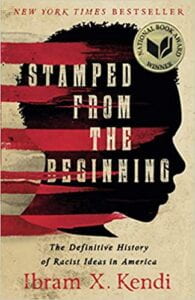
Kendi, I. X. (2016) Stamped from the Beginning: The Definitive History of Racist Ideas in America. New York: Nation Books.
Some Americans insist that we’re living in a post-racial society. But racist thought is not just alive and well in America–it is more sophisticated and more insidious than ever. And as award-winning historian Ibram X. Kendi argues, racist ideas have a long and lingering history, one in which nearly every great American thinker is complicit.
In this deeply researched and fast-moving narrative, Kendi chronicles the entire story of anti-black racist ideas and their staggering power over the course of American history. He uses the life stories of five major American intellectuals to drive this history: Puritan minister Cotton Mather, Thomas Jefferson, abolitionist William Lloyd Garrison, W.E.B. Du Bois, and legendary activist Angela Davis. As Kendi shows, racist ideas did not arise from ignorance or hatred. They were created to justify and rationalize deeply entrenched discriminatory policies and the nation’s racial inequities. In shedding light on this history, Stamped from the Beginning offers us the tools we need to expose racist.

Kendi, I.X & Blaine, K. (2021) Four Hundred Souls: a community history of African America, 1619-2019. New York: One World.
A “choral history” of African Americans covering 400 years of history in the voices of 80 writers, edited by the bestselling, National Book Award-winning historian Ibram X. Kendi and Keisha N. Blain. Together, they’ve gathered writers from various disciplines – historians, artists, journalists, and novelists – each of whom has contributed an entry about one five-year period to create a dynamic multi-voiced single volume history of Black people in America. [Online access available in Snell Library]
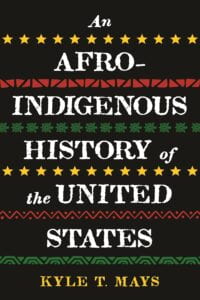
Mays, K.T (2021). An Afro-Indigenous History of the United States. Boston: Beacon Press.
Beginning with pre-Revolutionary America and moving into the movement for Black Lives and contemporary Indigenous activism, Afro-Indigenous historian, Kyle T. Mays argues that the foundations of the US are rooted in anti-blackness and settler colonialism, and that these parallel oppressions continue into the present. He explores how Black and Indigenous peoples have always resisted and struggled for freedom, sometimes together, and sometimes apart. Whether to end African enslavement and Indigenous removal or eradicate capitalism and colonialism, Mays show how the fervor of Black and Indigenous peoples calls for justice have consistently sought to uproot white supremacy.
Understanding the Origins of Race and Racism

Kanopy. (2014). Race: The Power of Illusion. 3 episodes.
The division of the world’s peoples into distinct groups – “red,” “black,” “white” or “yellow” peoples – has become so deeply embedded in our psyches, so widely accepted, many would promptly dismiss as crazy any suggestion of its falsity. Yet, that’s exactly what this provocative, new three-hour series by California Newsreel claims. Race – The Power of an Illusion questions the very idea of race as biology, suggesting that a belief in race is no more sound than believing that the sun revolves around the earth. Yet race still matters. Just because race doesn’t exist in biology doesn’t mean it isn’t very real, helping shape life chances and opportunities. By asking, What is this thing called ‘race’?, a question so basic it is rarely asked, Race – the Power of an Illusion helps set the terms that any further discussion of race must first take into account. Ideal for human biology, anthropology, sociology, American history, American studies, and cultural studies.
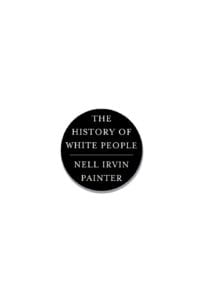
Painter, N.I. (2010). The History of White People. New York: WW. Norton.
Historian Nell Irvin Painter centers her study of racial classification on the slave trade and the nation-building efforts which dominated the United States in the 18th century, when thinkers led by Ralph Waldo Emerson strove to explain the rapid progress of America within the context of white superiority. Her research is filled with frequent, startling realizations about how tenuous and temporary our racial classifications really are.

Thomas Jefferson: Notes on Virginia
Jefferson’s chronicle of the natural, social, and political history of Virginia is at once a scientific discourse, an attempt to define America, and a brilliant examination of the idea of freedom.
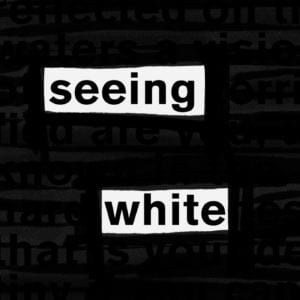
Williams, L. (Editor). (Feb – Aug. 2021). Seeing White: Scene On Radio Podcast.
Just what is going on with White people? Police shootings of unarmed African Americans. Acts of domestic terrorism by white supremacists. The renewed embrace of raw, undisguised White-identity politics. Unending racial inequity in schools, housing, criminal justice, and hiring. Some of this feels new, but in truth it’s an old story. Why? Where did the notion of “whiteness” come from? What does it mean? What is whiteness for? Scene on Radio host and producer John Biewen took a deep dive into these questions, along with an array of leading scholars and regular guest Dr. Chenjerai Kumanyika, in this fourteen-part documentary series, released between February and August 2017.
Intersectionality and Complex Identities

Crenshaw, K. (2014). On Intersectionality: essential writings. New York: The World Press.
In this comprehensive and accessible introduction to Crenshaw’s work, readers will find key essays and articles that have defined the concept of intersectionality, collected together for the first time. The book includes a sweeping new introduction by Crenshaw as well as prefaces that contextualize each of the chapters. For anyone interested in movement politics and advocacy, or in racial justice and gender equity, On Intersectionality will be compulsory reading from one of the most brilliant theorists of our time.
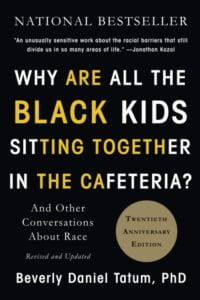
Tatum, B.D. (2017). Why Are All the Black Kids Sitting Together in the Cafeteria? And Other Conversations about Race. New York: Penguin.
Beverly Daniel Tatum, a renowned psychology Professor, guides us through how racial identity develops, from very young children to adulthood, in Black families, White families, and mixed-race families, and helps us understand what we can do to break the silence, have better conversations with our children and with each other about race, and build a better world.
Concepts of Whiteness and White Identity Development
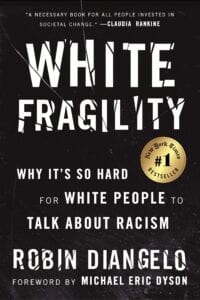
DiAngelo, R. (2018). White Fragility: Why It’s So Hard for White People to Talk about Racism. Boston: Beacon Press.
Antiracist educator Robin DiAngelo deftly illuminates the phenomenon of white fragility and “allows us to understand racism as a practice not restricted to ‘bad people’ (Claudia Rankine). Referring to the defensive moves that White people make when challenged racially, white fragility is characterized by emotions such as anger, fear, and guilt, and by behaviors including argumentation and silence. These behaviors, in turn, function to reinstate white racial equilibrium and prevent any meaningful cross-racial dialogue. In this in-depth exploration, DiAngelo examines how white fragility develops, how it protects racial inequality, and what we can do to engage more constructively.
Understanding Systemic and Structural Racism

Duvernay, A. (2018) 13th: A Documentary. Netflix. YouTube.
Combining archival footage with testimony from activists and scholars, director Ava DuVernay’s examination of the US prison system looks at how the country’s history of racial inequality drives the high rate of incarceration in America.

Kendi, I.X. (2019). How to be an AntiRacist. New York: One World.
Anti-racism is a transformative concept that reorients and reenergizes the conversation about racism—and, even more fundamentally, points us toward liberating new ways of thinking about ourselves and each other. At its core, racism is a powerful system that creates false hierarchies of human value; its warped logic extends beyond race, from the way we regard people of different ethnicities or skin colors to the way we treat people of different sexes, gender identities, and body types. Racism intersects with class and culture and geography and even changes the way we see and value ourselves. In How to Be an Antiracist, Kendi takes readers through a widening circle of antiracist ideas—from the most basic concepts to visionary possibilities—that will help readers see all forms of racism clearly, understand their poisonous consequences, and work to oppose them in our systems and in ourselves.
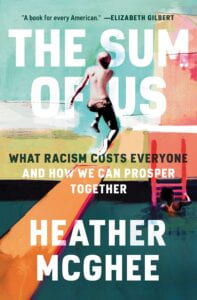
McGhee, H. (2021). The Sum of Us: What Racism Costs Everyone and How we Can Prosper Together. New York: One World.
Heather McGhee’s specialty is the American economy—and the mystery of why it so often fails the American public. From the financial crisis to rising student debt to collapsing public infrastructure, she found a common root problem: racism. But not just in the most obvious indignities for people of color. Racism has costs for White people, too. It is the common denominator of our most vexing public problems, the core dysfunction of our democracy and constitutive of the spiritual and moral crises that grip us all. But how did this happen? And is there a way out?
How to Have Difficult Conversations and Dialogue
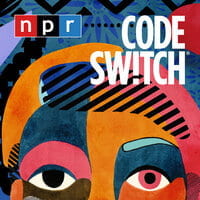
CodesSwitch (May 2016 – Present). National Public Radio (NPR).
What’s CODE SWITCH? It’s the fearless conversations about race that you’ve been waiting for. Hosted by journalists of color, this podcast tackles the subject of race with empathy and humor. It explores how race affects every part of society — from politics and pop culture to history, food and everything in between.
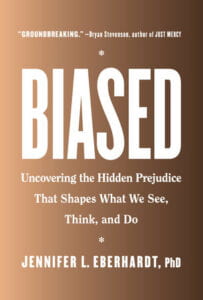
Eberhardt, J. (2019). Biased: Uncovering the Hidden Prejudice that Shapes What We See, Think, and Do. New York: Penguin Random House.
Jennifer Eberhardt unpacks the subtle repercussions of implicit bias in how teachers grade students, or managers deal with customers. She offers practical suggestions for reform and new practices that are useful for organizations and individuals. Eberhardt reminds us that racial bias is a human problem that all people have a role in solving.

Oluo, I. (2018). So You Want to Talk about Race. Seal Press.
In So You Want to Talk About Race, Ijeoma Oluo offers a contemporary, accessible take on the racial landscape in America, addressing head-on such issues as privilege, police brutality, intersectionality, micro-aggressions, the Black Lives Matter movement, and the “N” word. Perfectly positioned to bridge the gap between people of Color and White Americans struggling with race complexities, Oluo answers the questions listeners don’t dare ask and explains the concepts that continue to elude everyday Americans.

Walker, M. (2020). When Getting Along is Not Enough: Reconstructing Race in Our Lives and Our Relationships. Teachers College Press.
Now more than ever, race has become a morphing relational dynamic that has less to do with the demographic census box we check and more with how we make sense of our lives—who we are and who we can become in relationship with others. Using anecdotes from her practice as a licensed psychologist and as an African American growing up in the South, Walker provides a way for educators and social service professionals to enter into cross-racial discussions about race and race relations. She identifies three essential relational skills for personal transformation and cultural healing that are the foundations for repairing the damage wrought by racism. While Walker does not sugarcoat the destructive history of racism that we all inherit in the United States, the book’s vision is ultimately affirming, empowering, hopeful, and inclusive about the individual and collective power to heal our divisions and disconnections.
Teaching or Facilitating Concepts of Social Justice
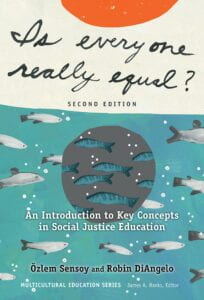
Sensoy, Ö. & DiAngelo, R.(2017). Is Everyone Really Equal?: An Introduction To Key Concepts in Social Justice Education. 2nd Ed. New York: Teachers College Press.
Özlem Sensoy and Robin DiAngelo provide understanding for many of the most common stumbling blocks to understanding social justice. This comprehensive resource includes new features such as a chapter on intersectionality and classism; discussion of contemporary activism (Black Lives Matter, Occupy, and Idle No More); material on White Settler societies and colonialism; pedagogical supports related to “common social patterns” and “vocabulary to practice using”; and extensive updates throughout.
This text is accessible to students from high school through graduate school. It is also a great professional development resource for practical classroom management and curriculum. The key concepts in social justice education include many user-friendly features, examples, and vignettes to not just define but illustrate the concepts. [Online access available in Snell Library]
Assignments, Activities, and Sample Syllabi
Writing Prompt: Write your encounter or discovery narrative. Think about the first time you became aware of your race, ethnicity, gender, religion, orientation or even your privilege (advantage). Describe the encounter. Revisit this narrative from time to time as you learn and grow in anti-racist work.
Social Identity Wheel: The Social Identity Wheel worksheet is an activity that encourages students to identify social identities and reflect on the various ways those identities become visible or more keenly felt at different times, and how those identities impact the ways others perceive or treat them.